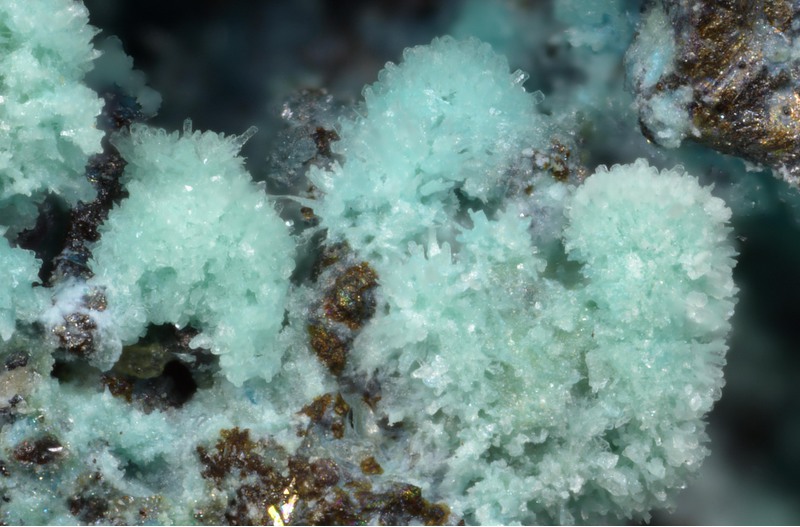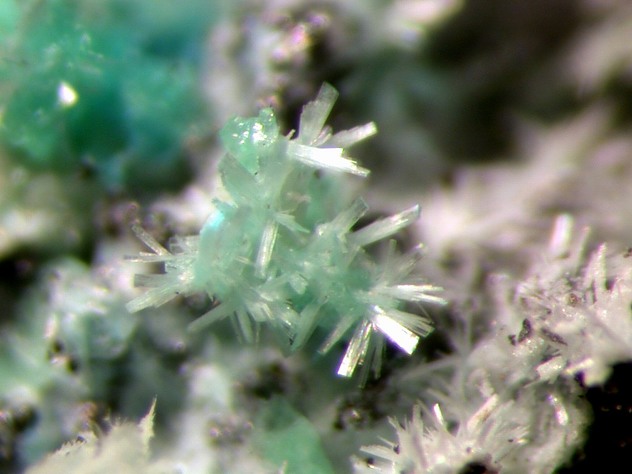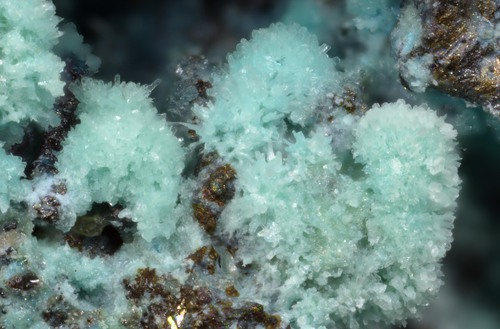Pushcharovskite
A valid IMA mineral species
This page is currently not sponsored. Click here to sponsor this page.
About Pushcharovskite
Formula:
K0.6Cu18[AsO2(OH)2]4[AsO3OH]10(AsO4)(OH)9.6 · 18.6H2O
Note: Although the type material was described as having very minor essential K, synthetic material and K-free finds from other localities (e.g. Lavrion) show that K is not essential.
Colour:
Colorless to light green
Lustre:
Vitreous
Specific Gravity:
3.35
Crystal System:
Triclinic
Name:
Named after Prof. Dmitry Yurievich Pushcharovsky (b. 1944), crystallographer, Moscow State University, Russia.
This page provides mineralogical data about Pushcharovskite.
Unique Identifiers
Mindat ID:
7258
Long-form identifier:
mindat:1:1:7258:4
GUID
(UUID V4):
(UUID V4):
60b9630f-da3e-42b5-8d24-372c4b171320
IMA Classification of Pushcharovskite
Approved
First published:
1997
Classification of Pushcharovskite
8.CA.55
8 : PHOSPHATES, ARSENATES, VANADATES
C : Phosphates without additional anions, with H2O
A : With small and large/medium cations
8 : PHOSPHATES, ARSENATES, VANADATES
C : Phosphates without additional anions, with H2O
A : With small and large/medium cations
Mineral Symbols
As of 2021 there are now IMA–CNMNC approved mineral symbols (abbreviations) for each mineral species, useful for tables and diagrams.
| Symbol | Source | Reference |
|---|---|---|
| Pus | IMA–CNMNC | Warr, L.N. (2021). IMA–CNMNC approved mineral symbols. Mineralogical Magazine, 85(3), 291-320. doi:10.1180/mgm.2021.43 |
Physical Properties of Pushcharovskite
Vitreous
Transparency:
Transparent
Colour:
Colorless to light green
Streak:
White
Tenacity:
Fragile
Cleavage:
Perfect
Perfect {010} and good {001}
Perfect {010} and good {001}
Fracture:
Fibrous
Density:
3.35(2) g/cm3 (Measured) 3.34(1) g/cm3 (Calculated)
Optical Data of Pushcharovskite
Type:
Biaxial (+)
RI values:
nα = 1.602(2) nβ = 1.642(2) nγ = 1.725(5)
2V:
Measured: 70° (3), Calculated: 73°
Max Birefringence:
δ = 0.123

Image shows birefringence interference colour range (at 30µm thickness)
and does not take into account mineral colouration.
and does not take into account mineral colouration.
Surface Relief:
Moderate
Dispersion:
r > v medium
Pleochroism:
Non-pleochroic
Chemistry of Pushcharovskite
Mindat Formula:
K0.6Cu18[AsO2(OH)2]4[AsO3OH]10(AsO4)(OH)9.6 · 18.6H2O
Note: Although the type material was described as having very minor essential K, synthetic material and K-free finds from other localities (e.g. Lavrion) show that K is not essential.
Note: Although the type material was described as having very minor essential K, synthetic material and K-free finds from other localities (e.g. Lavrion) show that K is not essential.
Crystallography of Pushcharovskite
Crystal System:
Triclinic
Cell Parameters:
a = 6.435(2) Å, b = 11.257(4) Å, c = 18.662(9) Å
α = 74.90(6)°, β = 86.48(7)°, γ = 83.59(4)°
α = 74.90(6)°, β = 86.48(7)°, γ = 83.59(4)°
Ratio:
a:b:c = 0.572 : 1 : 1.658
Unit Cell V:
1,296.28 ų (Calculated from Unit Cell)
Z:
12
Morphology:
Type material: individual crystals are elongate [100] to 0.5 mm, flattened on (010) to 0.04 mm width, showing {010}.
Twinning:
Polysynthetically twinned on (010)
Comment:
Point Group: 1 or 1; Space Group: P1 or P1.
Crystal Structure
Load
Unit Cell | Unit Cell Packed
2x2x2 | 3x3x3 | 4x4x4
Unit Cell | Unit Cell Packed
2x2x2 | 3x3x3 | 4x4x4
Show
Big Balls | Small Balls | Just Balls | Spacefill
Polyhedra Off | Si Polyhedra | All Polyhedra
Remove metal-metal sticks
Big Balls | Small Balls | Just Balls | Spacefill
Polyhedra Off | Si Polyhedra | All Polyhedra
Remove metal-metal sticks
Display Options
Black Background | White Background
Perspective On | Perspective Off
2D | Stereo | Red-Blue | Red-Cyan
Black Background | White Background
Perspective On | Perspective Off
2D | Stereo | Red-Blue | Red-Cyan
View
CIF File Best | x | y | z | a | b | c
CIF File Best | x | y | z | a | b | c
Rotation
Stop | Start
Stop | Start
Labels
Console Off | On | Grey | Yellow
Console Off | On | Grey | Yellow
Data courtesy of the American Mineralogist Crystal Structure Database. Click on an AMCSD ID to view structure
| ID | Species | Reference | Link | Year | Locality | Pressure (GPa) | Temp (K) |
|---|---|---|---|---|---|---|---|
| 0006814 | Pushcharovskite | Pushcharovsky D Y, Teat S J, Zaitsev V N, Zubkova N V, Sarp H (2000) Crystal structure of pushcharovskite European Journal of Mineralogy 12 95-104 | 2000 | 0 | 293 |
CIF Raw Data - click here to close
X-Ray Powder Diffraction
Powder Diffraction Data:
| d-spacing | Intensity |
|---|---|
| 18.3 Å | (25) |
| 11.00 Å | (100) |
| 3.171 Å | (30) |
| 2.952 Å | (50) |
| 2.920 Å | (60) |
| 2.816 Å | (50) |
| 2.492 Å | (25) |
Geological Environment
Paragenetic Mode(s):
| Paragenetic Mode | Earliest Age (Ga) |
|---|---|
| Stage 7: Great Oxidation Event | <2.4 |
| 47a : [Near-surface hydration of prior minerals] | |
| 47d : [Arsenates, antimonates, selenates, bismuthinates] |
Type Occurrence of Pushcharovskite
General Appearance of Type Material:
Colorless to light green tufts and acicular, radial fibrous aggregates to 1 mm in diameter
Place of Conservation of Type Material:
Department of Mineralogy, Natural History Museum of Geneva, Switzerland
Associated Minerals at Type Locality:
Reference:
Sarp, H., Sanz-Gysler, J. (1997) Pushcharovskite, Cu(AsO3)(OH).H2O, a new mineral from Cap Garonne (Var, France). Archives des Sciences, Genève: 50: 177-186.
Synonyms of Pushcharovskite
Other Language Names for Pushcharovskite
Common Associates
Associated Minerals Based on Photo Data:
Related Minerals - Strunz-mindat Grouping
| 8.CA. | Davidlloydite | Zn3(AsO4)2 · 4H2O |
| 8.CA. | Apexite | NaMg(PO4) · 9H2O |
| 8.CA. | Brandãoite | BeAl2(PO4)2(OH)2(H2O)5 |
| 8.CA.05 | Fransoletite | Ca3Be2(PO4)2(PO3OH)2 · 4H2O |
| 8.CA.05 | Parafransoletite | Ca3Be2(PO4)2(PO3OH)2 · 4H2O |
| 8.CA.10 | Ehrleite | Ca4Be3Zn2(PO4)6 · 9H2O |
| 8.CA.15 | Faheyite | Be2Mn2+Fe3+2(PO4)4 · 6H2O |
| 8.CA.20 | Gainesite | Na(Na,K)(Be,Li)Zr2(PO4)4 · 1.5-2H2O |
| 8.CA.20 | Mccrillisite | NaCs(Be,Li)Zr2(PO4)4 · 1-2H2O |
| 8.CA.20 | Selwynite | NaK(Be,Al)Zr2(PO4)4 · 2H2O |
| 8.CA.25 | Pahasapaite | Li8(Ca,Li,K)10.5Be24(PO4)24 · 38H2O |
| 8.CA.30 | Hopeite | ZnZn2(PO4)2 · 4H2O |
| 8.CA.30 | Arsenohopeite | Zn3(AsO4)2 · 4H2O |
| 8.CA.30 | Nizamoffite | Mn2+Zn2(PO4)2(H2O)4 |
| 8.CA.30 | Unnamed (Mg-analogue of Hopeite) | Mg3(PO4)2 · 4H2O |
| 8.CA.35 | Warikahnite | Zn3(AsO4)2 · 2H2O |
| 8.CA.40 | Phosphophyllite | Zn2Fe(PO4)2 · 4H2O |
| 8.CA.42 | Steinmetzite | Zn2Fe3+(PO4)2(OH) · 3H2O |
| 8.CA.45 | Parascholzite | CaZn2(PO4)2 · 2H2O |
| 8.CA.45 | Scholzite | CaZn2(PO4)2 · 2H2O |
| 8.CA.50 | Keyite | Cu2+3Zn4Cd2(AsO4)6 · 2H2O |
| 8.CA.60 | Prosperite | Ca2Zn4(AsO4)4 · H2O |
| 8.CA.65 | Gengenbachite | KFe3+3(PO3OH)4[PO2(OH)2]2 · 6H2O |
| 8.CA.70 | Parahopeite | Zn3(PO4)2 · 4H2O |
| 8.CA.70 | Reaphookhillite | MgZn2(PO4)2 · 4H2O |
| 8.CA.75 | Stergiouite | CaZn2(AsO4)2 · 4H2O |
| 8.CA.80 | Limousinite | BaCa[Be4P4O16] · 6H2O |
| 8.CA.85 | Minjiangite | BaBe2(PO4)2 |
| 8.CA.85 | Wilancookite | (Ba5Li2◻)Ba6Be24P24O96 · 26H2O |
Fluorescence of Pushcharovskite
Not fluorescent
Other Information
Notes:
Soluble in dilute HCl
Health Risks:
No information on health risks for this material has been entered into the database. You should always treat mineral specimens with care.
Internet Links for Pushcharovskite
mindat.org URL:
https://www.mindat.org/min-7258.html
Please feel free to link to this page.
Please feel free to link to this page.
Search Engines:
External Links:
Mineral Dealers:
References for Pushcharovskite
Reference List:
Sarp, H., Sanz-Gysler, J. (1997) La pushcharovskite, Cu(AsO3,OH)·H2O un nouveau minéral de la mine de Cap Garonne, Var (France) Archives des Sciences, Genève, 50 (3) 177-186
Plumhoff, Alexandra M., Plášil, Jakub, Dachs, Edgar, Benisek, Artur, Sejkora, Jiří, Števko, Martin, Rumsey, Mike S., Majzlan, Juraj, Plumhoff, Alexandra M., Plášil, Jakub, Dachs, Edgar, Benisek, Artur, Sejkora, Jiří, Števko, Martin, Rumsey, Mike S., Majzlan, Juraj (2020) Thermodynamic properties, crystal structure and phase relations of pushcharovskite [Cu(AsO3OH)(H2O) ⋅ 0.5H2O], geminite [Cu(AsO3OH)(H2O)] and liroconite [Cu2Al(AsO4)(OH)4 ⋅ 4H2O]. European Journal of Mineralogy, 32 (3) 285-304 doi:10.5194/ejm-32-285-2020
Localities for Pushcharovskite
Locality List
 - This locality has map coordinates listed.
- This locality has map coordinates listed.
 - This locality has estimated coordinates.
ⓘ - Click for references and further information on this occurrence.
? - Indicates mineral may be doubtful at this locality.
- This locality has estimated coordinates.
ⓘ - Click for references and further information on this occurrence.
? - Indicates mineral may be doubtful at this locality.
 - Good crystals or important locality for species.
- Good crystals or important locality for species.
 - World class for species or very significant.
(TL) - Type Locality for a valid mineral species.
(FRL) - First Recorded Locality for everything else (eg varieties).
- World class for species or very significant.
(TL) - Type Locality for a valid mineral species.
(FRL) - First Recorded Locality for everything else (eg varieties).
All localities listed without proper references should be considered as questionable.
Czech Republic | |
| M.E. Ciriotti - 04.06.2008 - Probed |
France | |
| Sarp et al. (1997) +1 other reference |
| Sarp et al. (1997) |
Greece | |
| Branko Rieck collection (self-collected, PXRD- and SEM-EDS-analysed by Petra Marschner in January 2020) +2 other references |
Quick NavTopAbout PushcharovskiteUnique IdentifiersIMA Classification Classification Mineral SymbolsPhysical Properties Optical Data Chemistry Crystallography Crystal StructureX-Ray Powder DiffractionGeological EnvironmentType Occurrence SynonymsOther LanguagesCommon AssociatesStrunz-MindatFluorescence Other InformationInternet Links References Localities Locality List






 symbol to view information about a locality.
The
symbol to view information about a locality.
The 




Salsigne mine, Salsigne, Carcassonne, Aude, Occitanie, France